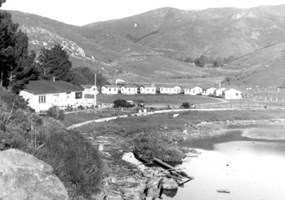
George Kristian Lindholt The Marin coast is a majestic physical setting for the unfolding story of nature and humans at Muir Beach. The interplay of geology, topography, and climate slowly produced the coastal scrub and prairie habitats that once covered the Headlands. Tall stands of native bunch grasses swayed in the ocean breezes. The dramatic slopes of the coastal bluffs housed showy wildflowers. Redwood Creek surged through this landscape. A massive freshwater and brackish lagoon spread out for over twenty five acres along the shore. Within these distinctive habitats plants and animals evolved together. Bald eagles and giant condors glided through the air. Mountain lions, bobcats, and red wolf packs stalked the grasslands hunting jackrabbits, elk, and deer. Grizzly and black bears lumbered along the shores. Muir Beach was a wild and beautiful place. The Marin Headlands were once covered with prosperous dairy farms. In 1856, Samuel Throckmorton took control of Rancho Sausalito and leased the land to Portuguese dairymen. By the 1880s, Marin County was California’s largest producer of fresh milk and butter. Much of this success was based on the hard-work of the recent immigrants, known as the Azoreans. Originally from the Azores, an archipelago of rural islands west of Iberian Portugal, these men arrived in California on whaling ships. Those who did not find their fortune in gold were able to use their native dairy experience to get jobs in Marin’s newly-established dairy ranches. Muir Beach and Frank’s Valley was a small agricultural community. The chain of migrations from the Azores to Sausalito were sustained by intermarriage and strong social connections, largely based in the Roman Catholic Church. In particular, Sausalito’s Saint Mary’s Star of the Sea, founded in 1881, was where the Portuguese were most visible as a community. The Holy Ghost Hall still holds traditional Portuguese festivities to this day. Muir Beach was earlier known as Bello Beach after Antonio Bello, a Portuguese settler who supposedly bought the entire hillside for a $10 gold piece. In 1919, Bello established a hotel at Muir Beach and began subdivisions for blue collar summer cabins. In 1945, the adjacent green Gulch pasture was purchased by George Wheelwright. In the early 1960s he extensively modified Redwood Creek and constructed the leveee downstream of Pacific Way. The area was heavily grazed for decades. In the 1950s Bay Area urbanites began to move into this formerly isolated area. They brought with them respect for rural life, but also the new urban culture of the Bohemians and Beatniks that increasingly contrasted with that of the small farm community. A decade later the Old Tavern became a dance hall, nurturing the new generation of psychedelic bands, some of which like Big Brother and the Holding Company went on to national fame. It is actually rumored that Janis Joplin’s ashes were spread at Muir Beach. The tavern and cottages at the beach were removed in the late 1960s after California State Parks acquired the beach. |
Last updated: February 26, 2025
